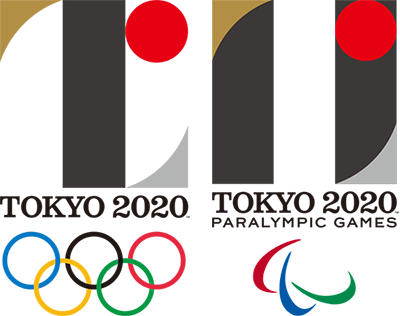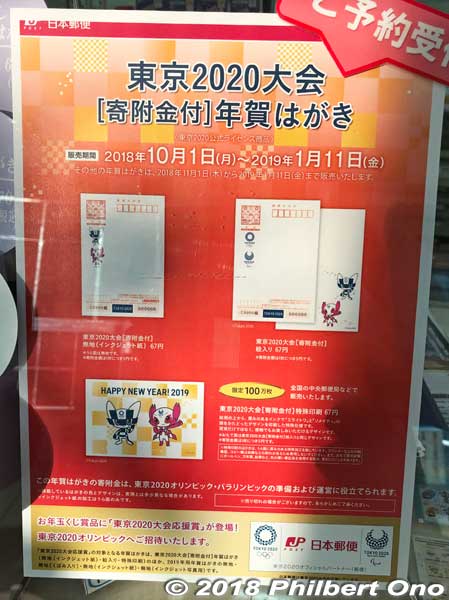First page of this comprehensive chronology (timeline) of significant developments and events from 2011 to 2022 (multiple pages) related to the Tokyo 2020 Olympics and Paralympics held during a worldwide COVID-19 pandemic in summer 2021.
It traces Tokyo winning the bid to host the 2020 Summer Games, the planning stages, the high expectations, the drastic effects of COVID-19, the one-year postponement, the negativity in mass media and social media, gaffes and controversies, COVID-19 countermeasures, the culmination of a safe summer Games in 2021, and immediate aftermath of relief, appreciation, and venue dismantling or reversion.
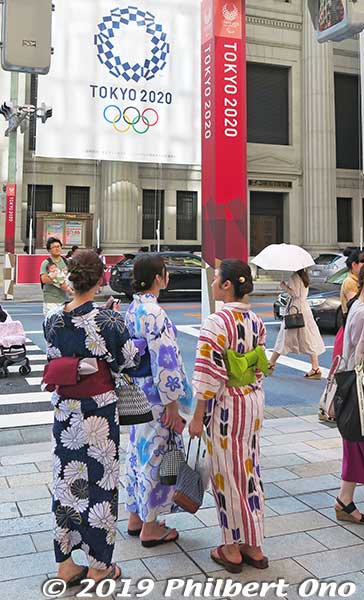
Postponed by one year, the Tokyo 2020 Olympics was held on July 23–August 8, 2021 and Tokyo Paralympics dates were August 24–September 5, 2021.
Updated: Nov. 5, 2023
Compiled and written by Philbert Ono (former TOCOG employee). Preserving Tokyo 2020 history, images, and memories.
Scroll down or go to year:
2011 | 2012 | 2013 | 2014 | 2015
2016 | 2017 | 2018 | 2019 | 2020 | 2021
Olympics | Paralympics | Venues | 2022-2023
Abbreviations
IOC: International Olympic Committee
IPC: International Paralympic Committee
TOCOG: Tokyo Organising Committee of the Olympic and Paralympic Games
TMG: Tokyo Metropolitan Government
NOC: National Olympic Committee
NPC: National Paralympic Committee
Five organizers: TOCOG, IOC, IPC, TMG, and government of Japan
WHO: World Health Organization
All venues also have a three-letter abbreviation.
🔴 Important events and milestones for Tokyo 2020.
🍀 Important developments and milestones for Games volunteers (“Field Cast”).
*Japanese personal names are written with the family name before the given name.
*Click/tap on the image thumbnail to enlarge the image.
*Special thanks to Games volunteer friends and staff who contributed photos.
*To correct any errors in this chronology, contact us.
Tokyo 2020 Chronology (Page 1/5): 2011–2018
2011
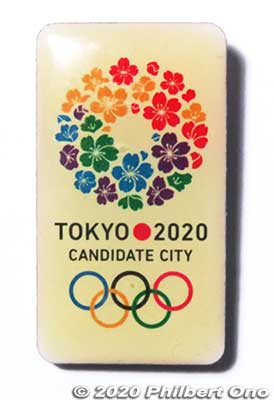
March 11, 2011: Huge earthquake and tsunami devastate the Tohoku Region of Japan, especially Fukushima, Miyagi, and Iwate Prefectures. Over 19,000 deaths, over 2,500 missing, and over 6,000 injured (as of March 2021).
Nuclear power plants in Fukushima are also damaged and disabled with radiation leakage and partial meltdowns. Hundreds of thousands of residents are affected. Tokyo also gets a big jolt, but damage is comparatively minor.
May 16, 2011: IOC sends letters of invitation to National Olympic Committees (NOCs) to submit bids for the 2020 Summer Olympics-Paralympics. Deadline to submit bids is September 1, 2011.
🔴 July 16, 2011: Tokyo Governor Ishihara Shintaro announces that Tokyo will bid to host the 2020 Olympics and Paralympics. Tokyo had earlier bid for the 2016 Summer Olympics, but lost to Rio de Janeiro on October 3, 2009.
Tokyo is selected by the Japanese Olympic Committee as Japan’s candidate city for the 2020 Games. Joint candidate cities Hiroshima and Nagasaki drop out due to a lack of local support and funding.
🔴 August 30, 2011: Tokyo submits its official bid for the 2020 Summer Games to the JOC and IOC.
September 2, 2011: IOC announces that they have received six bids for the 2020 Summer Games from Istanbul, Tokyo, Baku, Doha, Madrid, and Rome. Rome later drops out.
September 7, 2011: Japanese Olympic Committee announces that Tokyo Governor Ishihara Shintaro will be Chairman of the Tokyo 2020 bid committee.
September 15, 2011: Tokyo 2020 bid committee for the 2020 Summer Games is formed.
November 30, 2011: Tokyo’s Candidate City logo is unveiled, showing a colorful wreath of cherry blossoms.
2012

February 2012: Decision is made to demolish the old Japan National Stadium, venue for the 1964 Tokyo Olympics, to make way for a new national stadium.
July 27–August 12, 2012: London 2012 Summer Olympics are held.
August 20, 2012: Massive crowd of 500,000 pack the streets of Ginza to wildly cheer Japan’s London 2012 Olympic medalists (72 of them) waving from atop five open-roof buses in an Olympic victory parade. They bring in a then record haul of 38 medals. Medalists included swimmer Kitajima Kosuke, gymnast Uchimura Kohei, wrestlers Icho Kaori and Yoshida Saori, judoka Matsumoto Kaori, table tennis Fukuhara Ai, hammer thrower Murofushi Koji, and the women’s football team.
The first Olympic victory parade ever to be held in Japan. Parade lasted only 20 minutes along a 1 km route along Chuo-dori. Buses also had banners encouraging Tokyo’s successful bid for the 2020 Summer Games. (Video here.) Official photos here.
August 29–September 9, 2012: London 2012 Summer Paralympics are held.
October 25, 2012: Ishihara Shintaro resigns as Tokyo Governor to form a new political party.
November 15, 2012: From 46 design applicants, the design of the new Japan National Stadium (Olympic Stadium) by architect Zaha Hadid is selected and revealed.
December 14, 2012: The proposed golf venue is changed from Wakasu Golf Links in Koto Ward to the larger Kasumigaseki Country Club in Saitama. The golf club is later urged by the IOC to change its rule to allow female members to join the men-only golf club.
December 16, 2012: Lieutenant Governor Inose Naoki wins the Tokyo gubernatorial election by a landslide to replace Ishihara Shintaro. Inose takes over as head of Tokyo 2020 bid committee.
December 26, 2012: Abe Shinzo is elected as Japan’s prime minister for the second time and serves the longest term in Japan’s history until September 16, 2020. He becomes a staunch supporter of Tokyo 2020 and “Honorary Supreme Advisor” on TOCOG’s Advisory Meeting board.
2013
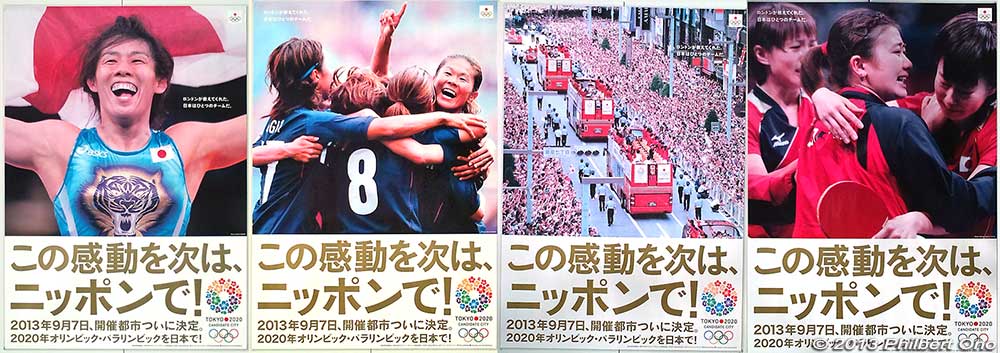
January 2013: Public opinion polls show a large majority of Tokyo residents and the Japanese public in favor of Tokyo’s 2020 Olympics bid.
February 12, 2013: IOC discusses the possibility of removing wrestling as a competitive sport at the 2020 Summer Games.
March 4–7, 2013: IOC Evaluation Commission visits Tokyo for on-site inspections as a candidate city.
March 5, 2013: Survey by the IOC shows 70 percent of Tokyo residents in favor of holding the 2020 Summer Games.
April 26, 2013: In a New York Times interview, Tokyo Governor Inose Naoki states that, “Islamic countries, the only thing they share in common is Allah and they are fighting with each other, and they have classes”, in reference to candidate city Istanbul. He later apologizes for the remark, and the IOC reiterates that candidate cities are forbidden to publicly criticize or compare with other cities.
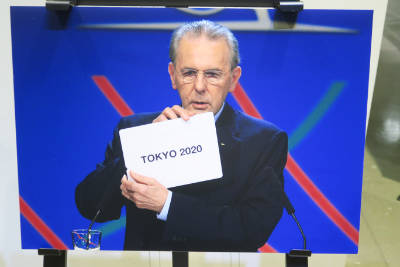
🔴 September 7, 2013: At the 125th IOC Session in Buenos Aires, Tokyo as a candidate city gives a 45-minute presentation to promote its bid for the Summer 2020 Games. One of the presenters, Bid Ambassador Christel Takigawa, mentions the now-famous Japanese expression, “o-mo-te-na-shi” (defined as “the spirit of selfless hospitality”). Short PR videos by all three candidate cities are also shown.
Tokyo is elected as the host city for the 2020 Summer Olympics-Paralympics in a final vote against Istanbul. Announced by IOC President Jacques Rogge who held up a sign indicating “Tokyo.” The Japanese delegation jump up and scream with joy.
https://olympics.com/en/news/ioc-selects-tokyo-as-host-of-2020-summer-olympic-games
September 7, 2013: The IOC votes to keep wrestling for the 2020 Games while dropping baseball, softball, and squash to the great disappointment to the athletes and fans of those sports.
September 10, 2013: IOC Vice President Thomas Bach is elected IOC President for an eight-year term succeeding Jacques Rogge. Representing West Germany, he was an Olympic gold medalist in foil fencing at Montreal 1976.
November 26, 2013: Panel of leading experts make a proposal to scale down the design and cost of the new National Stadium (Olympic Stadium).
November 30, 2013: During his first trip to Japan as IOC President, Thomas Bach expresses the flexibility of also keeping baseball and software at the 2020 Summer Games.
December 19, 2013: Tokyo Governor Inose Naoki announces his resignation as governor due to his money scandals. His gubernatorial term becomes Tokyo’s shortest in history at 372 days.
2014
🔴 January 24, 2014: The Tokyo Organising Committee of the Olympic and Paralympic Games (TOCOG, 東京オリンピック・パラリンピック競技大会組織委員会) is formed with 44 employees and former prime minister Mori Yoshiro as President and Muto Toshiro as CEO or Director-General. TOCOG employees eventually expand to 7,000 during the Games.
TOCOG later revises the bid committee’s original proposals for venues and decide to use existing facilities for 60 percent of the venues instead of only 40 percent as originally proposed. This reduces the cost by ¥200 billion, and sustainability becomes a major theme along with “Recovery Olympics” in reference to the devastated Tohoku Region. “Diversity and Inclusion” is also a recurrent theme.
February 9, 2014: Masuzoe Yoichi wins the Tokyo gubernatorial election following the resignation of Inose Naoki.
February 7–24, 2014: Sochi 2014 Winter Olympics are held in Russia.
February 20, 2014: TOCOG President Mori Yoshiro comments that Japanese Olympic figure skater Asada Mao always falls at the most important moments. A few days later at a press conference, Asada reacts by saying that she doesn’t fall on purpose, and that Mori probably now regrets what he said, drawing laughter from the press.
March 7–16, 2014: Sochi 2014 Winter Paralympics are held in Russia.
Old Japan National Stadium (1964 Tokyo Olympic Stadium)
May 2014: For a few months until May 22, 2014, “Sayonara Tours” of the old Japan National Stadium is held for the public. It was the Olympic Stadium for the 1964 Tokyo Olympics. Every day, thousands flocked to see the stadium for the last time. The historic structure is to be torn down to make way for the new Olympic Stadium for Tokyo 2020. On May 31, 2014, a final sayonara event is held at the stadium with famous soccer players, etc.
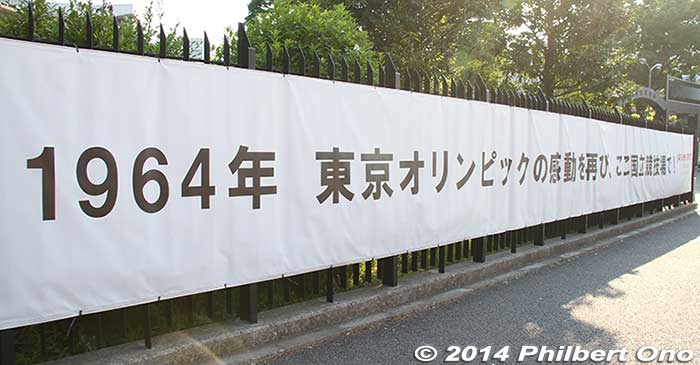
「1964年 東京オリンピックの感動を再び、ここ国立競技場で!」
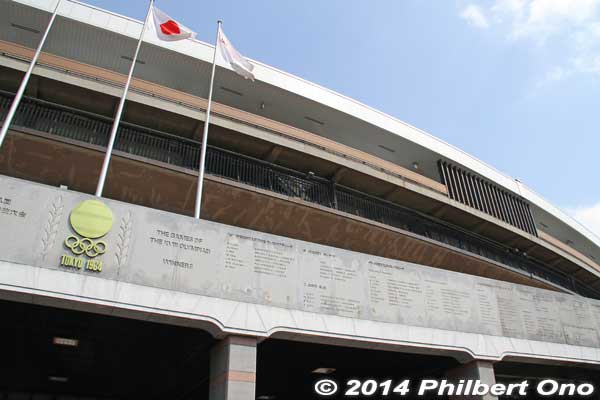
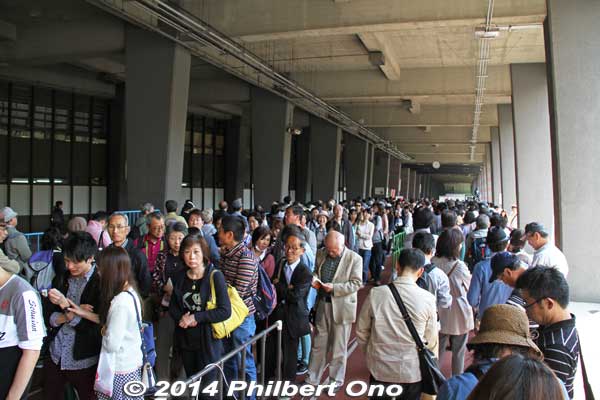
B: Big crowd line up to tour the old National Stadium.
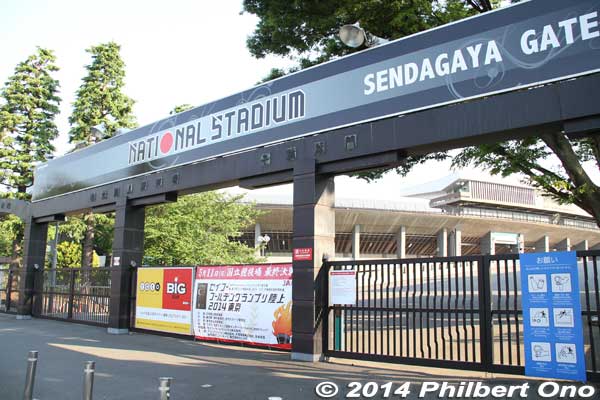


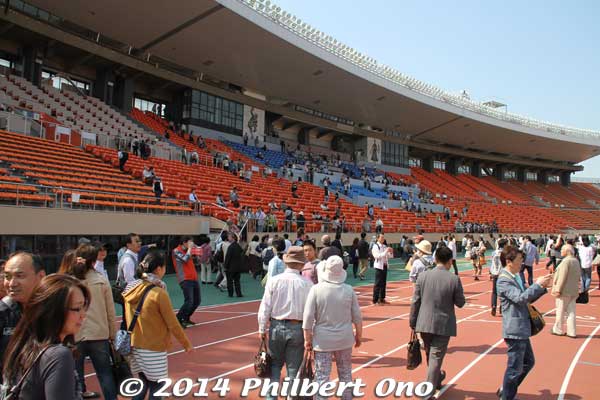
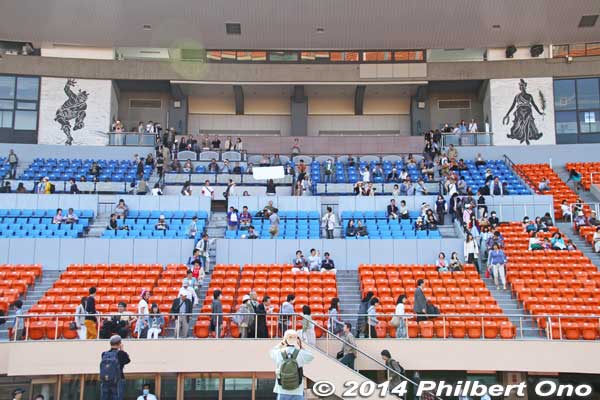
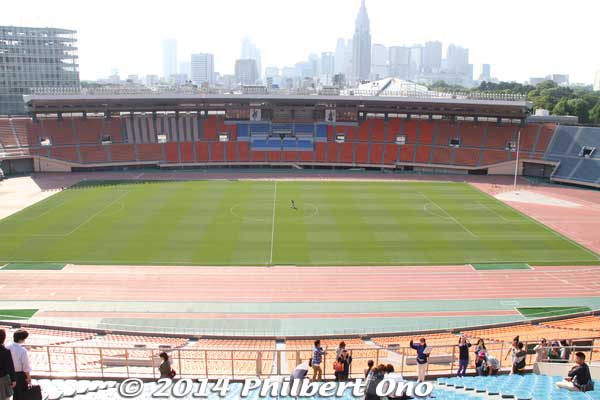
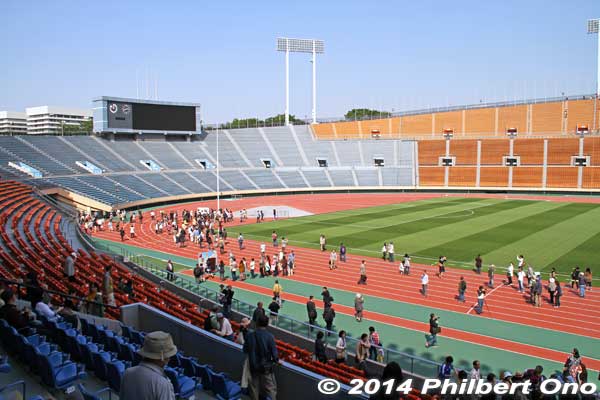
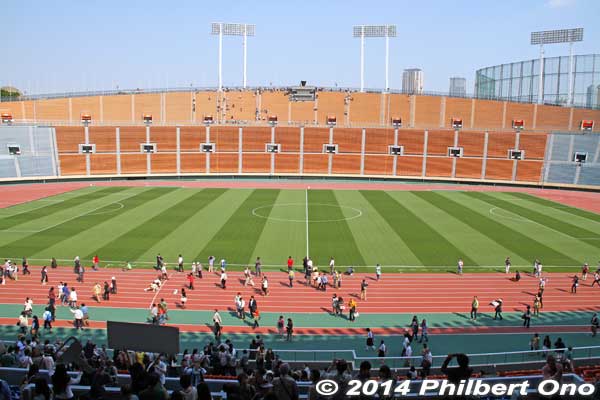
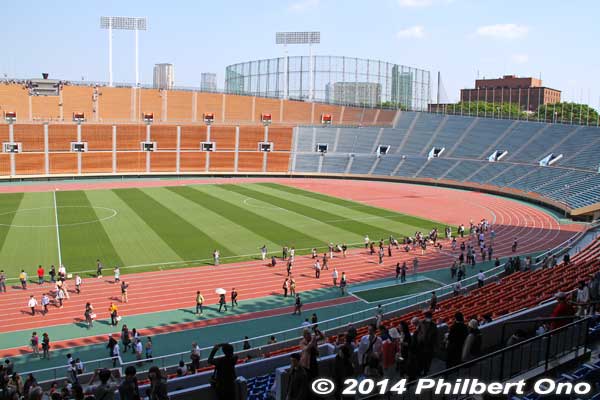
C: Sendagaya Gate was where final torch bearer Sakai Yoshinori (19, 坂井 義則) received the Olympic torch and took it to light the cauldron in the stadium. Sakai was born in the city of Miyoshi in Hiroshima Prefecture on the day the Hiroshima atomic bomb was dropped. He failed to make it on the Olympic team’s 400m and 1600m relay teams and never competed in any Olympics. He was picked to symbolize Japan’s postwar recovery.
D: Olympic flame cauldron aflame on top of the stands. The steps on the left was where Sakai Yoshinori ran up to light the cauldron on the opening day of the 1964 Olympics.
E: Olympic flame cauldron. It’s not that big, only 2.1 meters diameter. Designed by a blacksmith in Kawaguchi, Saitama Prefecture.
F: Grandstand of the old stadium. We could walk on the track, but not on the grass.
G: On the main grandstand, a pair of large fresco wall murals by Hasegawa Roka (長谷川路可 1897–1967). On the left is Nomi no Sukune, a legendary sumo wrestler posing as a victor. On the right is the Greek Goddess of Victory, depicting “Honor.” Both murals were moved to the new Japan National Stadium.
H: Soccer field and grandstand.
I: Stadium entrance where athletes entered during the 1964 Tokyo Olympics Opening Ceremony.
J: Views of the stadium. The soccer field has real grass.
June 10, 2014: Citing spiraling costs in construction materials and labor, Tokyo Governor Masuzoe states that the venue construction plans will be revamped to reduce costs.
June 26, 2014: Led by John Coates, the IOC Coordination Commission visits Tokyo for three days to inspect the progress of Games preparations and venues. They also hear the revamped plans for venue construction. Coates states that venue modifications should be made while consulting international sports federations within two or three months.
August 15, 2014: It is announced that an agreement was reached between TOCOG and FINA to use Tatsumi International Swimming Center for water polo instead of building the temporary Water Polo Arena as originally planned.
November 19, 2014: Tokyo Governor Masuzoe announces that three of the ten venues to be newly constructed would be scrapped to reduce the cost by almost half. New venues would not be built for basketball and badminton. Meanwhile, new venues for volleyball, swimming, rowing, and canoe slalom would be built as planned.
November 27, 2014: City of Sapporo announces its intention to bid for the 2026 Winter Games. However, it later withdraws its bid on September 13, 2018 in favor of the 2030 Winter Games.
December 8, 2014: In reforming the Olympics, IOC members meeting in Monaco agree to abolish the limit of having 28 sports at the Summer Games and instead limit the number of events to 310 and athletes to 15,000.
The host city would also be allowed to propose the addition of more sports and hold events outside the city or even outside the country. This opened the door to adding baseball and softball much beloved in Japan and having events in cities far from Tokyo. Tokyo Governor Masuzoe states the next day that he wants competitions to also be held in the Tohoku Region.
2015
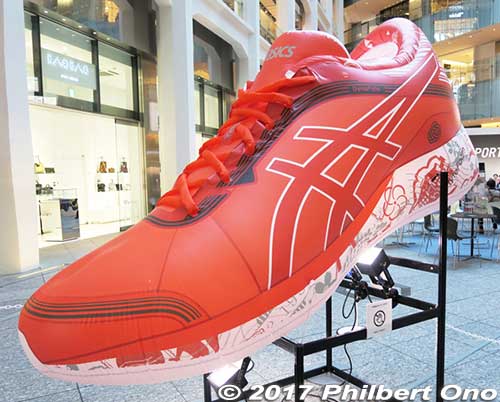
2015: Total sponsorship for Tokyo 2020 reaches approximately US$1.3 billion, setting an Olympics record. (The amount eventually more than doubles.) Multiple sponsors in the same business category are also accepted. For example, ANA and JAL are both official airline sponsors.
Tokyo 2020 Olympic and Paralympics sponsors eventually reach record numbers: 81 companies for the Olympics and 80 companies for the Paralympics. They include Worldwide Olympic Sponsors, Tokyo 2020 Gold Partners, Tokyo 2020 Official Partners, and Tokyo 2020 Official Supporters. Sponsors are to hold events such as Let’s 55 (Go-go), 1 Year to Go!, and produce the 2020 Fan Park and Fan Area (in Odaiba).
High-profile sponsors include Toyota (transport vehicles), ASICS (apparel for volunteers/referees/athletes, sports wear, sports gear), Atos (IT services), Coca-Cola (non-alcoholic drinks), Omega (clocks, timekeeper, scoreboards), Panasonic (TVs, PCs, AV), Canon (still cameras, desktop printers), Samsung (cell phones, tablets, wireless communications), Visa (payment services), Asahi Beer (beer, wine), Meiji (ice cream, dairy products, confections), Japan Post (commemorative stamps, pins), NTT (telecommunications), JAL, ANA, JR East and Tokyo Metro, Yamato Holdings (courier service), and Tokyo Skytree. https://www.tokyo2020.jp/ja/organising-committee/marketing/sponsors/index.html
February 27, 2015: TOCOG proposes to the IOC Executive Board to have basketball held at the existing Saitama Super Arena instead of building a venue in Koto Ward, to use Baji Koen (Equestrian Park) instead of building a temporary venue in Koto Ward, and to move the canoe slalom venue from Kasai Rinkai Park to an adjacent site. The proposals are approved.
March 30, 2015: In an interview with NHK, a WHO official points out that Olympic host city Tokyo still does not have an ordinance to provide non-smoking spaces in restaurants. Restaurants, coffee shops, etc., in Tokyo eventually provide non-smoking spaces to the delight of non-smokers.
June 12, 2015: TOCOG announces that 26 sports federations have applied to have the host city add their sport to the 2020 Olympics. They include baseball, softball, karate, sumo, tug-of-war, bowling, chess, and billiards. Eight candidate sports are later selected including baseball/softball, karate, bowling, and wushu.
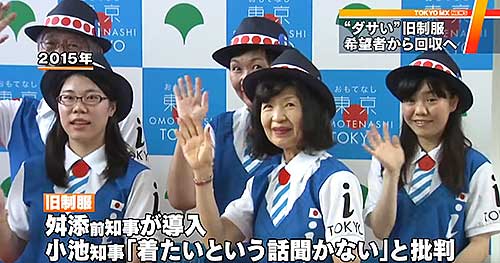
June 19, 2015: TMG’s own volunteer tour guide program for foreign tourists named “Omotenashi Tokyo” is launched with 1,300 volunteer tour guides guiding tourists in Shinjuku and Ueno while wearing widely criticized uniforms selected by Tokyo Governor Masuzoe Yoichi. One prominent Japanese fashion designer thought the uniform looked like a clown’s outfit.
TMG plans to increase the number of volunteer tour guides to 3,000 by the year 2020 and expand to Ginza and Roppongi. The poorly received uniforms cost ¥30.15 million to produce 3,735 sets of four uniform items. The uniform is later redesigned in November 2016 under the order of Tokyo Governor Koike.
June 23, 2015: City of Paris announces its intention to bid for the 2024 Summer Olympics.
June 25, 2015: For the Japanese government’s preparation of the Tokyo 2020 Games, Endo Toshiaki is appointed as the first Cabinet-level Olympics Minister.
July 17, 2015: Prime Minister Abe announces that architect Zaha Hadid‘s design of the new Japan National Stadium would be scrapped due to spiraling construction costs and criticism of the intrusive design by Japanese architects, including Kuma Kengo whose stadium design is later chosen. Most of the ¥6 billion spent for the architectural design is unlikely to be returned, and there are fears that Hadid would sue for the cancellation (Hadid never sued).
July 24, 2015: Tokyo 2020 emblems designed by Sano Kenjiro are unveiled. It supposed to look like a “T” for Tokyo, Team, and Tomorrow.
September 1, 2015: Accusations of plagiarism against Tokyo 2020 emblem designer Sano Kenjiro result in his emblems being scrapped. https://www.japantimes.co.jp/news/2016/01/27/national/crime-legal/belgian-designer-drops-suit-tokyo-2020-olympics-logo-cites-legal-costs/
This coming soon after the scrapping of the architectural design of the Olympic Stadium alarms the Japanese public and raises doubts about the competence of the Japan staging the Games and having the stadium built in time.
TOCOG later reveals in Jan. 2016 that the scrapped emblems cost over ¥100 billion spent for the unveiling event, trademark registration, and other expenses.
September 18, 2015: For the redesign of the new Japan National Stadium, Zaha Hadid Architects scales down their stadium design. However, they abandon their pursuit of the project since they could not find any willing contractor in Japan to build it, a precondition for the contract bidding.
October 1, 2015: The new Japan Sports Agency to nuture and promote sports in Japan is established under the Ministry of Education, Culture, Sports, Science and Technology with Suzuki Daichi as the agency’s first commissioner.
November 16–December 7, 2015: Design submissions from the public to replace the scrapped Tokyo 2020 emblems are accepted from individuals and groups. A design background is no longer required. Total 14,599 submissions are received, many more than the 104 entries received the first time.
December 2015: A new design for the Japan National Stadium (Olympic Stadium) created by architect Kuma Kengo is chosen. He assures a worried Japanese public that the stadium would be constructed in time for the Olympics. However, it would be too late for the 2019 Rugby World Cup.
2016
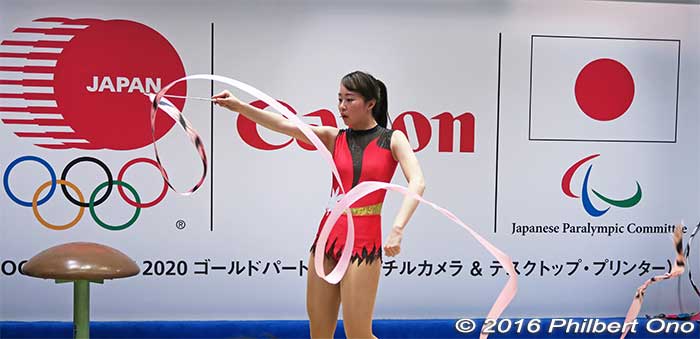
January 26, 2016: Japanese government announces the first list of host towns (44 municipalities) where Olympic national teams will have their training camps before the Games. Many more host towns are eventually added, totaling 138 by the end of 2016 and later reaching over 500.
April 8, 2016: From among 14,599 entries from the public, four candidate designs for the official Tokyo 2020 emblems are announced. Public opinions about the candidate designs are accepted and taken into consideration for the final selection voted by a panel of 21 prominent designers, artists, sports figures, lawyers, etc., who have met and deliberated for 110 hours total. https://www.nikkei.com/article/DGXLASDG08H9R_Y6A400C1CC1000/

🔴 April 25, 2016: The official emblems/logos for the Tokyo 2020 Olympics and Paralympics are selected and unveiled to replace the allegedly plagiarized emblems. Asao Tokolo wins the emblem design contest. His emblems have indigo-coloured, traditional Japanese checkered patterns called ichimatsu moyo (市松模様). https://olympics.com/en/olympic-games/tokyo-2020/logo-design
May 2016: Large Tokyo 2020 exterior billboards featuring the official emblem and mascots are installed on TMG buildings in Shinjuku. (Removed in Dec. 2021.)
🔴 June 1, 2016: During a board meeting in Laussane, the IOC approves the addition of baseball, softball, karate, skateboarding, sports climbing, and surfing for the 2020 Summer Olympics. They are approved for being popular in Japan and drawing in younger people.
June 15, 2016: Tokyo Governor Masuzoe Yoichi resigns after widespread disapproval of his extravagant spending of political and public funds for personal use. Another major embarrassment for Tokyo 2020. Masuzoe had wanted to delay his resignation until the Rio Olympics so he could receive the Olympic flag during the Closing Ceremonies at Maracanã Stadium.
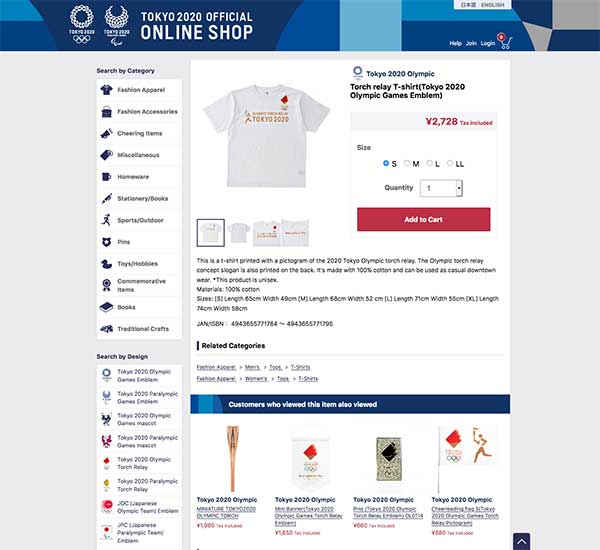
🔴 June 23, 2016: The Tokyo 2020 Official Online Shop opens for business. It sells merchandise from 128 licensed companies and eventually stocks a record 7,871 licensed products mostly featuring the official emblem(s) and mascots. However, it does not ship products overseas. Total 67 physical shops also open nationwide from July 2018 and mostly operate until autumn 2021. https://tokyo2020shop.jp/
July 25, 2016: TOCOG announces that it will recruit 80,000 Games volunteers for Tokyo 2020 from summer 2018.
🔴 July 31, 2016: To replace disgraced Tokyo Governor Masuzoe Yoichi, Koike Yuriko is elected Tokyo Governor, Tokyo’s first woman governor to finally bring some stability to TMG.
July 2016: Due to the increasing number of inbound tourists and lack of hotel rooms in Tokyo, new luxury hotels start to open or are under construction in time for the Tokyo Olympics.
August 5–21, 2016: Rio 2016 Summer Olympics are held in Rio de Janeiro, Brazil. Although medical doctors urged the Games to be canceled due to the Zika virus, the Games did not have a problem with the virus.
August 12, 2016: Olympics Minister Marukawa Tamayo states that Japan will aim for 30 gold medals at Tokyo 2020. (Japan actually wins 27 gold medals.)
August 21, 2016: At the 2016 Summer Olympics closing ceremony, Tokyo Governor Koike Yuriko receives the Olympic Flag from the Mayor of Rio de Janeiro, Eduardo Paes.
September 7–18, 2016: Rio 2016 Summer Paralympics are held in Rio de Janeiro, Brazil.
Rio de Janeiro 2016 Olympic and Paralympic Victory Parade in Ginza, Tokyo
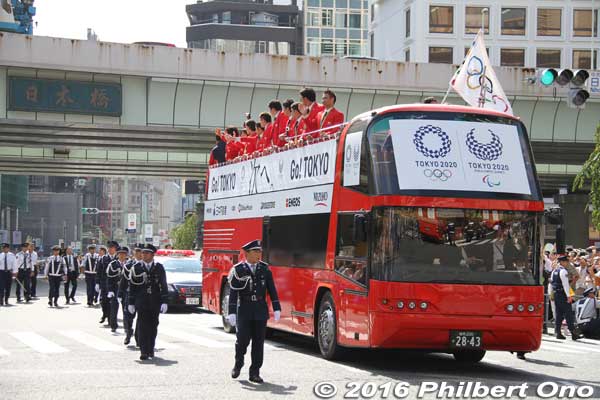
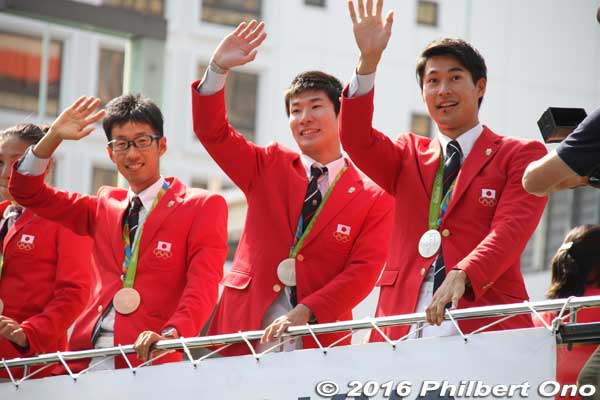
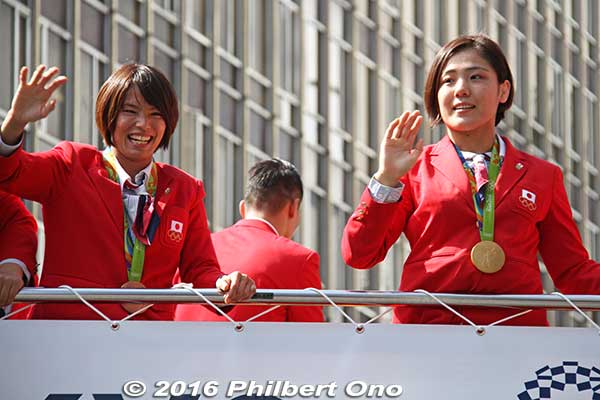
B: Kaori Matsumoto (judo bronze medalist in women’s -57 kg) and Haruka Tachimoto (women’s judo gold medalist, 70 kg).
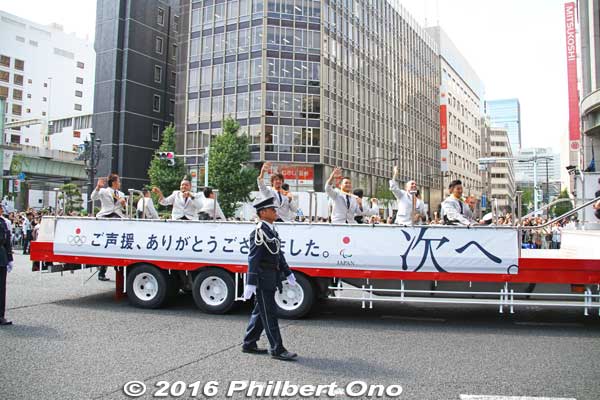
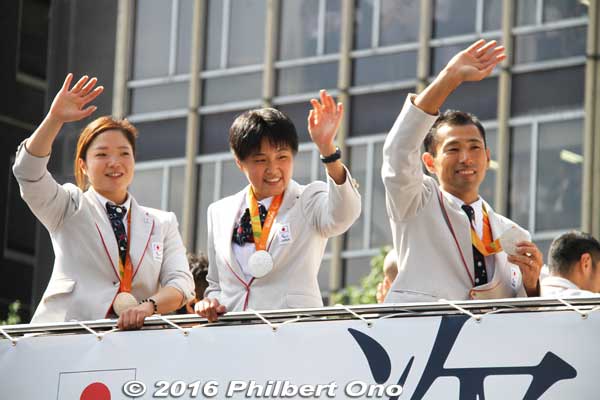
D: Tanaka Mai (Women’s tandem B cycling time trial silver medalist, pilot for Kanuma Yurie), Kanuma Yurie (Women’s tandem B cycling time trial silver medalist), Masaki Fujita (Road Cycling TT bronze medalist) 田中まい 鹿沼由理恵 藤田征樹
October 7, 2016: Massive crowd of 800,000 pack the streets of Ginza and Nihonbashi to wildly cheer Japan’s Rio 2016 Olympic and Paralympic medalists (65 Olympic medalists) waving from atop four double-decker, open top buses and two flatbed trucks in an Olympic-Paralympic victory parade. Olympians wore red uniforms while the Paralympians wore white.
They bring in a then record haul of 41 Olympic medals and 24 Paralympic medals. Olympic medalists included swimmers Hagino Kosuke and Seto Daiya, gymnasts Uchimura Kohei and Shirai Kenzo, wrestlers Icho Kaori, Kawai Risako and Dosh Sara, judoka Ono Shohei and Baker Mashu, sprinters Kiryu Yoshihide, Iizuka Shota, Yamagata Ryota, artistic swimmers Inui Yukiko and Mitsui Risako, and table tennis Ito Mima.
Paralympic medalists include swimmer Kimura Keiichi, runner Sato Tomoki, judoka Hirose Makoto, marathoner Michishita Misato, and the men’s wheelchair rugby team.
The parade went along a 2.5 km km route on Chuo-dori. Buses also had banners encouraging Tokyo’s success at the 2020 Summer Games. More photos here.
October 12, 2016: As part of ongoing venue cost reductions, Tokyo Governor Koike asks Miyagi Prefectural Governor Murai Yoshihiro to host the rowing venue at Naganuma Rowing Course (長沼ボート場). (Proposal is later abandoned, but makes Naganuma Rowing Course famous in the process.)
October 19, 2016: During a trip to Tokyo, Thomas Bach states that there are ideas to hold baseball/softball games in the Tohoku Region and that Prime Minister Abe welcomed it.
November 25, 2016: TMG forms a Tokyo brand review panel (東京ブランドの在り方検討会) to redesign the poorly received uniform selected by preceding Governor Masuzoe for Tokyo’s volunteer tour guides. Fashion designer Koshino Hiroko comments that the uniform looks like a clown costume. The new uniform is announced in September 2017.
November 29, 2016: TMG, TOCOG, IOC, and Japanese government decide to build Sea Forest Waterway for rowing and canoe and Tokyo Aquatics Centre for swimming.
December 7, 2016: In Lausanne, the IOC approves five more Tokyo 2020 venues: Yokohama Stadium for baseball/softball, Nippon Budokan for karate, the temporary Aomi Urban Sports Park for sport climbing and skateboarding (later moved to Ariake), and Tsurigasaki Beach for surfing.
December 11, 2016: Construction of the new Japan National Stadium (Olympic Stadium) begins by Taisei Corporation.
December 16, 2016: Tokyo Governor Koike announces that Ariake Arena would be newly constructed for volleyball as originally planned.
December 21, 2016: Organizers announce that Tokyo 2020 is projected to cost as much as ¥1.8 trillion. Includes ¥350 billion to build permanent venues and ¥280 billion for temporary venues.
2017
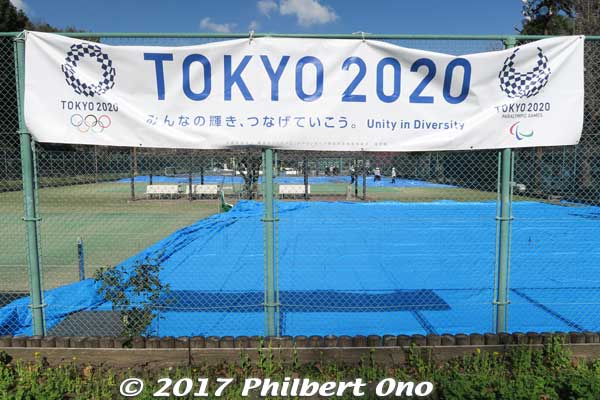
January 2017: Construction of the Olympic Village in Harumi begins. (Completed in December 2019.)
February 15, 2017: For one month from this day, TOCOG declines to conclude any new business contracts with advertising agency Dentsu, citing the extremely sad case of a young woman Dentsu employee, Takahashi Matsuri, who committed suicide at age 24 due to overwork (karoshi) at the company.
March 17, 2017: At a meeting in PyeongChang, the IOC approves Fukushima Azuma Baseball Stadium as a Tokyo 2020 venue for baseball/softball.
March 20, 2017: Kasumigaseki Country Club‘s board approves a change in club rules to allow females to join the club. Although the IOC had urged the club to allow women to join, the club does not cite the IOC’s request as its reason to change the rule.
April 1, 2017: TMG starts a two-year project named “Tokyo 2020 Medal Project” to collect and recycle precious metals from old cell phones and other small electronic devices from the public. The extracted metals would be used to make the Tokyo 2020 medals.
June 9, 2017: IOC decides to add 26 new events for 14 sports at Tokyo 2020. They include three-member judo teams and 3×3 basketball.
July 10, 2017: IOC approves Kashima Soccer Stadium in Ibaraki Prefecture as a Tokyo 2020 venue for football.
July 22, 2017: The sport of synchronized swimming is officially renamed “artistic swimming” by FINA. Tokyo 2020 is to be the first Olympics where the sport will appear under this new name.
August 1st–14th, 2017: TOCOG accepts submissions for the creation of Tokyo 2020’s official mascots. A total of 2,042 designs are submitted.
September 13, 2017: Paris is selected to be the host city for the 2024 Summer Games and Los Angeles for the 2028 Summer Games. Highly unusual for two Olympic host cities to be selected at the same time.
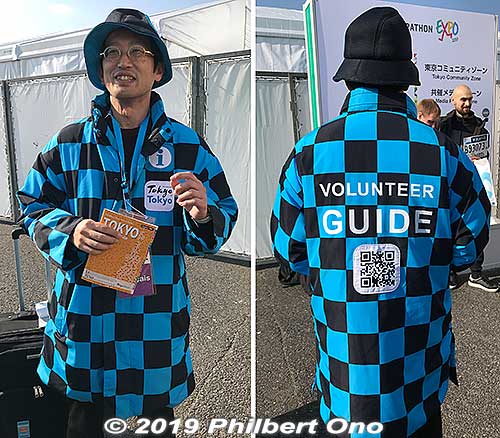
September 15, 2017: At a regular press conference, Tokyo Governor Koike shows the newly designed checkered uniform for Tokyo’s volunteer tour guides (different group from Tokyo 2020 City volunteers) for foreign tourists. The design is reminiscent of Tokyo 2020’s emblems with the ichimatsu moyo checkered pattern. The QR code on the back goes to Tokyo’s official tourist website.
It was to replace the old uniform widely criticized for being uncouth and many volunteers refused to wear. The new uniform was produced at a cost of ¥80 million. Volunteer tour guides would start wearing the new uniform from October 2017.
Due to the widespread demand among volunteer guides to return their old, unwanted uniforms, TMG started accepting their old uniforms from January 2018 for recycling.
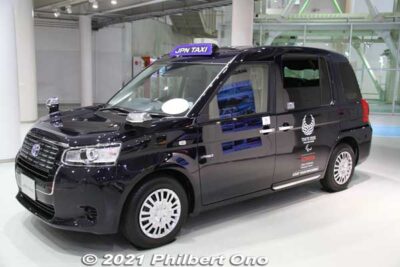
October 23, 2017: At MEGA WEB in Koto Ward, Tokyo, Toyota unveils its newly designed taxi cab for Tokyo 2020. With a higher roof and lower floor, the vehicle is designed like a mini-van that can even accommodate wheelchair users and a lot of luggage. The dark blue (almost black) taxis become ubiquitous in Tokyo sporting the Tokyo 2020 emblems on the doors.
Japanese government later states in Jan. 2018 that it wants at least one-fourth of all taxis in Tokyo to be able to take wheelchair-bound passengers by 2020. However, wheelchair users later notice that these taxis often refused to pick them up on the street. Taxi drivers say that it was a complicated and time-consuming procedure (too many steps) to board a wheelchair user. Wheelchairs users say that it would be easier if the taxis had a rear entrance instead of using the side door.
October 28, 2017: “1,000 Days To Go” Olympic countdown event is held in Tokyo’s Nihonbashi district with street banners, street entertainment, booths, and interactive activities. The commemorative events are held until November 29 (1000 days until the Paralympics).
New graphics combining the checkered ichimatsu moyo and a fireworks design are also unveiled.
November 25, 2017: Construction of the Musashino Forest Sport Plaza in Chofu (western Tokyo) is completed. Tokyo 2020’s first new permanent venue to be completed and an opening event is held this day.
November 29, 2017: For “1,000 Days To Go” until the Paralympics, Tokyo Skytree is illuminated with the three colors of the Agitos logo in the evening.
December 6, 2017: Basketball 3×3 venue is set for Aomi Urban Sports Park and BMX cycling at Ariake Urban Sports Park. Skateboarding is moved from Aomi to Ariake Urban Sports Park to reduce costs.
December 11, 2017–February 22, 2018: Kids at 16,769 Japanese elementary schools nationwide and overseas vote for one of three shortlisted pairs of Tokyo 2020 mascot candidates. One vote per class. https://olympics.com/ioc/news/tokyo-2020-unveils-mascot-shortlist
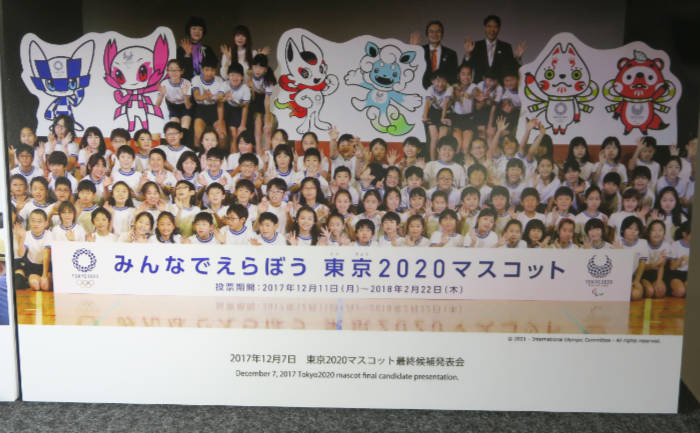
2018
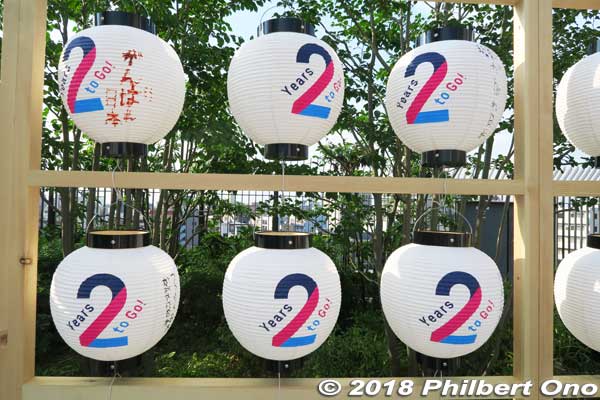
February 9–25, 2018: PyeongChang 2018 Winter Olympics are held in South Korea.
🔴 February 28, 2018: As decided by a vote by Japanese elementary school students, the Tokyo 2020 mascot designs by Taniguchi Ryo are announced as the winner. As a precondition for mascot designs, Taniguchi does not receive any royalties for his mascots.
March 9–18, 2018: PyeongChang 2018 Winter Paralympics are held in South Korea.
May 2, 2018: IOC board approves all of Tokyo 2020’s 43 venues. TOCOG also accepts the plan to secure 45,000 hotel rooms at 450 hotels for the Olympic Family (IOC, sports federations, etc.)
May 2, 2018: Ceremony is held at TMG to mark TMG receiving 100,000 old mobile phones to be recycled for their metals for the medals.
June 13, 2018: A special law is passed to make the Tokyo 2020 Opening Ceremony day and the day before national holidays. The day after the Closing Ceremony is also made a national holiday. Valid only for Tokyo 2020.
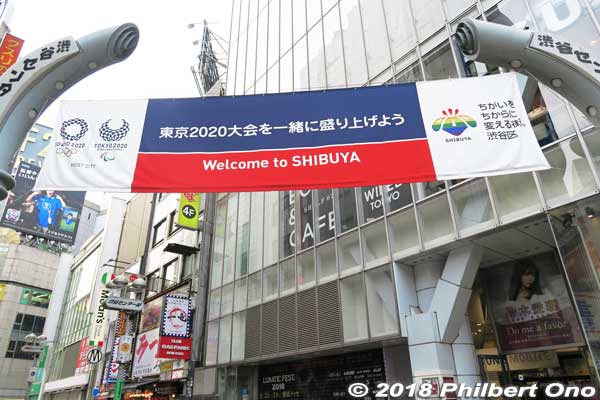
July 12, 2018: The decision is made to start the Olympic torch relay on March 26, 2020 from Fukushima.
July 20, 2018: TOCOG announces that the most expensive Tokyo 2020 ticket will be ¥300,000 for the Opening Ceremony and the cheapest ticket ¥2,500 for soccer.
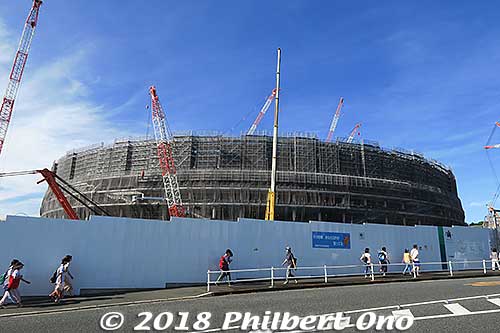

🔴 July 22, 2018: The Tokyo 2020 mascots selected by popular vote by elementary school children are named “Miraitowa” (Olympic mascot) and “Someity” (Paralympic mascot) by TOCOG. Miraitowa is named after the Japanese words mirai (未来, future) and towa (永久, eternity).
Someity is named after the popular Somei-Yoshino fluffy species of cherry blossom and after the phrase “so mighty.” Both mascots become widely used as Tokyo 2020 symbols and in official merchandise along with the checkered, official emblems.
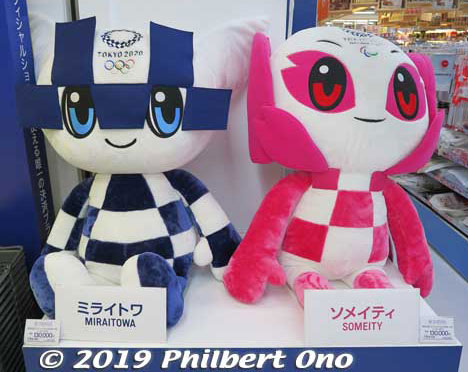
July 23, 2018: The first physical Tokyo 2020 Official Shop opens for business in BIC Camera in Shinjuku. Over 60 more physical shops eventually open all over Japan.
2 Years to Go!
🍀 July 24, 2018: “2 Years to Go!” event is held at the foot of Tokyo Skytree in Sumida Ward with hands-on games, PR booths, stage entertainment, PR event to recruit Tokyo 2020 volunteers, and an evening appearance by Governor Koike and Japanese athletes. Tokyo Skytree is also lit up in the five Olympic colors. https://www.city-volunteer.metro.tokyo.lg.jp/en/news/2018/1129_01.html
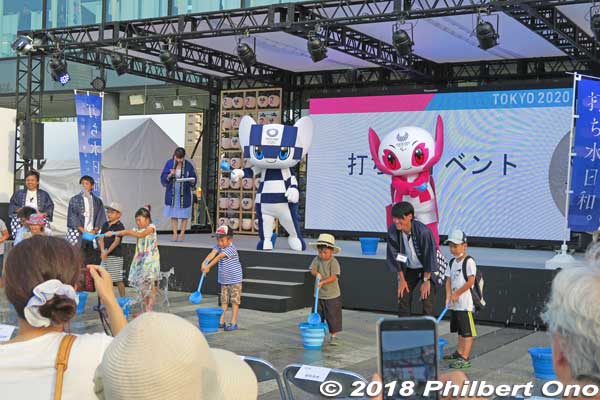
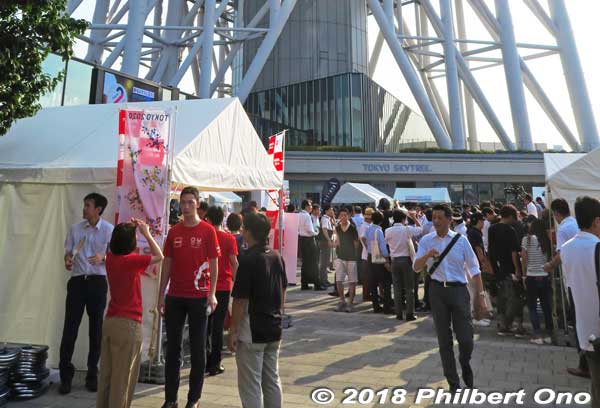
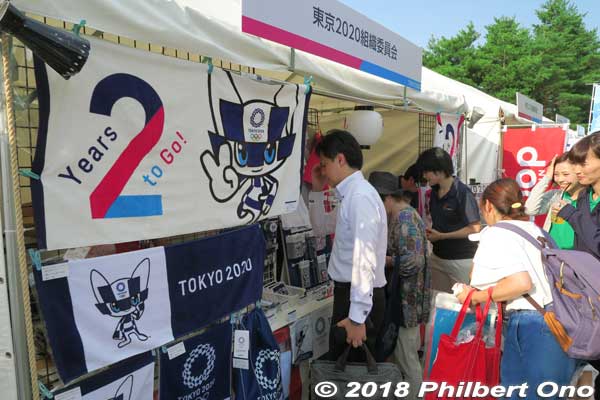
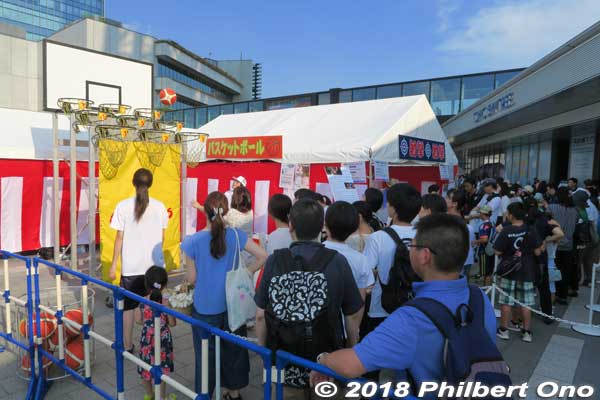
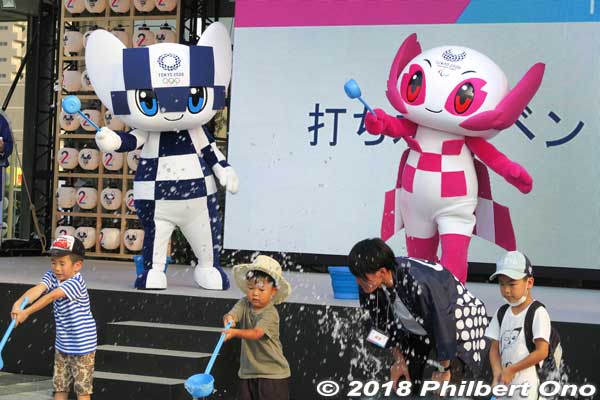
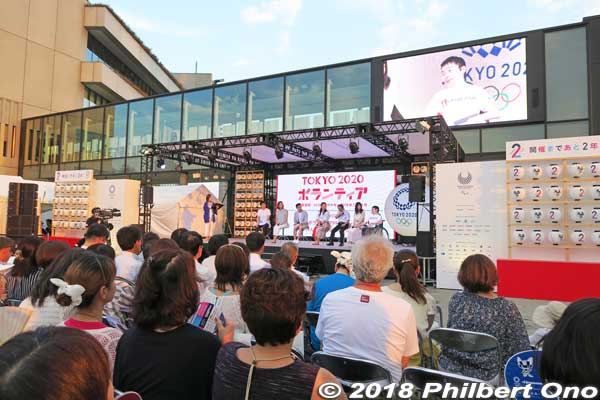
A: “2 Years to Go!” at the foot of Tokyo Skytree on a hot summer day.
B: TOCOG booth selling official goods.
C: Basketball challenge.
D: Miraitowa and Someity on stage sprinkling water to make it cool.
E: Tokyo 2020 Games volunteer PR event (talk show).
July 30, 2018: Kyogen actor Nomura Mansai is appointed as director of the Tokyo 2020 Opening and Closing Ceremonies programs.
August 9, 2018: The cycling road race route is decided between Chofu, Tokyo and Fuji International Speedway.
Core Graphics – Look of the Games
August 17, 2018: TOCOG unveils the basic, core graphics design of the Look of the Games featuring five traditional Japanese colors (not Olympic colors) of Kurenai red, Ai indigo blue, Sakura cherry blossom pink, Fuji wisteria purple, and Matsuba pine green. They were inspired by the color shade combinations of the traditional juni-hitoe multi-layer kimono worn by court nobles.
This basic design and colors soon make a major visual impact on the Games when incorporated in venues, ticket designs, volunteer uniforms, official merchandise, street banners, etc.
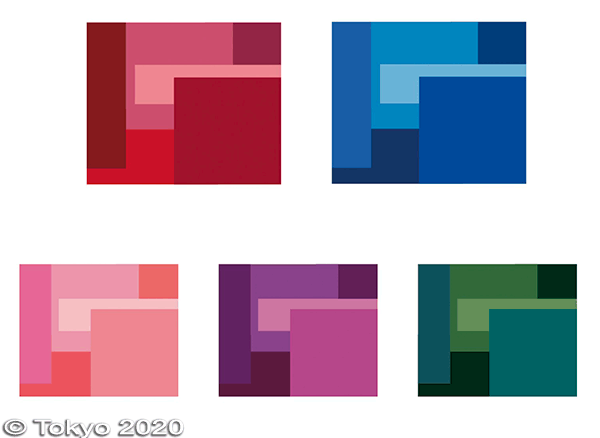
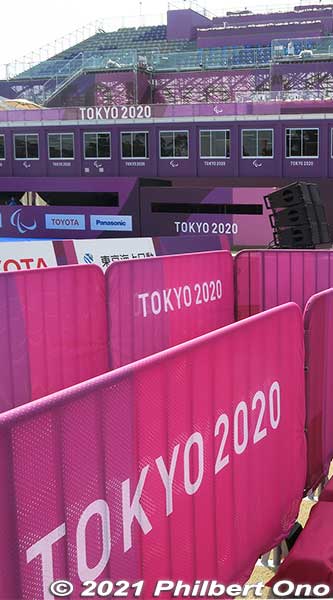
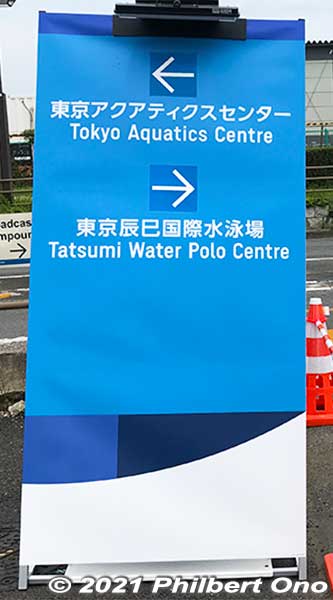
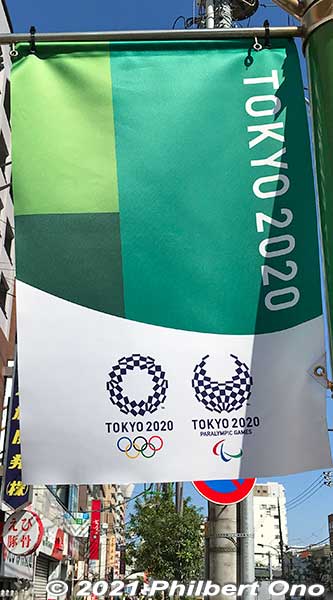
B: Indigo blue on signage in the aquatics park in Tatsumi.
C: Pine green on a street banner.
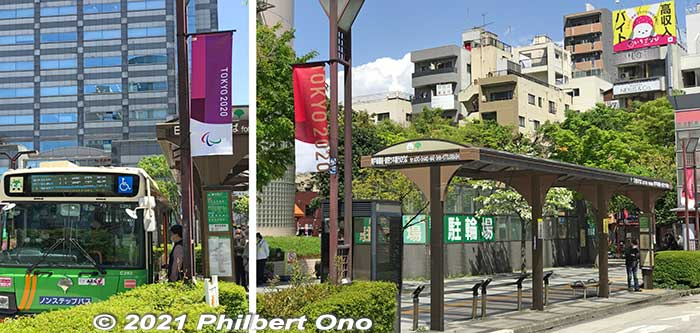
The Look of the Games at all 42 competition venues plus seven non-competition venues such as the Olympic Village and hotels is produced by Dai Nippon Printing Co., Ltd. They are in charge of printing and installing the decorative “core graphics” for the Look of the Games. They produce 20,000 items consisting of 7,000 kinds of decorations. The Look covers a total of 150,000 square meters or over three times the area of a baseball field.
August 24, 2018: TOCOG announces Paralympic ticket prices. The cheapest is ¥900 to make it affordable even for young people.
September 8, 2018: Osaka Naomi defeats Serena Williams in the US Open Tennis women singles final and becomes the first Japanese to win a Grand Slam title. After returning to Japan a few days later, she comments that she would aim for the gold medal if she can play at Tokyo 2020. She is eventually selected to represent Japan and also be the final torch bearer to light the cauldron at the Tokyo 2020 Olympic Opening Ceremony.
September 9–16, 2018: Tokyo 2020’s first test event, Sailing World Cup Series at Enoshima test event held at Enoshima Yacht Harbour.
September 17, 2018: The city of Sapporo officially informs the IOC that it would withdraw its bid for the 2026 Winter Olympics and instead bid for the 2030 Winter Games.
🍀September 18, 2019: TOCOG decides to give Games volunteers a daily allowance of ¥1,000 to cover transportation expenses.
🍀September 26–December 21, 2018: Applications to be Tokyo 2020 Games volunteers are accepted online through the official Tokyo 2020 volunteer website. They aim to recruit 80,000 Games volunteers.
TMG also seeks to recruit 30,000 City guide volunteers. https://www.city-volunteer.metro.tokyo.lg.jp/en/join/application/
Many people and media in Japan expressed doubts about getting that many applicants, the most ever for an Olympics. The number of applicants increases sharply toward the end of the deadline.
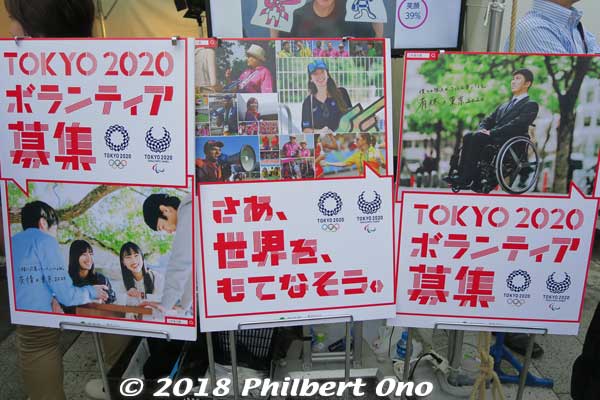
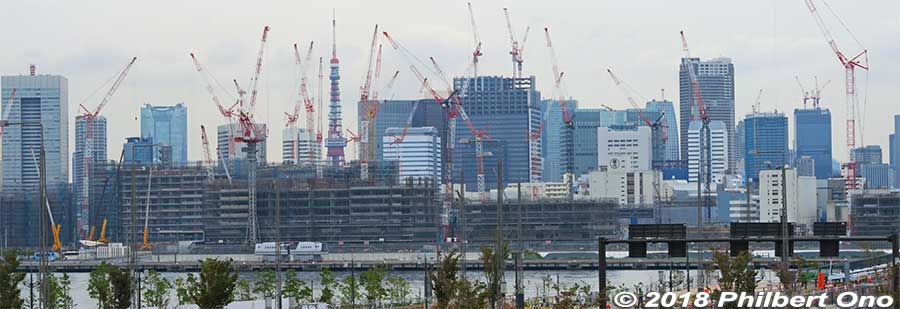
October 1, 2018: Japan Post Office starts the sale of 2019 nengajo New Year’s postcards printed with Tokyo 2020 emblems and mascots. Priced slightly more than regular New Year’s postcards, the proceeds would help defray the cost of Tokyo 2020. The postcards are sold until Jan. 11, 2019.
October 5–7, 2018: Japan Championships for Water Polo test event held at Tokyo Tatsumi International Swimming Center (Tatsumi Water Polo Centre).
October 17, 2018: It is discovered that earthquake resistance data for the Tokyo Aquatics Centre and Ariake Arena was falsified. The buildings’ earthquake dampers did not meet Japan’s safety standards.
November 30, 2018: Regarding the fate of the Tatsumi International Swimming Center (Tatsumi Water Polo Centre) after the Games, three proposals are reviewed: 1. Keep it as a pool. 2. Convert it into an ice rink. 3. Convert it into a gymnasium. (The ice rink proposal is eventually decided.)
November 2018: The first issue of a series of Tokyo 2020 Commemorative Coins is shipped by Japan Mint. They include ¥1000 and ¥100 coins designed with an Olympic or Paralympic sport such as aquatics, judo, fencing, and boccia. https://www.mof.go.jp/english/policy/currency/coin/commemorative_coins/20180622en.html

🍀December 11, 2018: For the Games volunteers’ nickname, TOCOG announces the final four candidates of “Field Cast,” “Games Anchor,” “Games Force,” and “Shining Blue.” They are shortlisted from 149 proposed nicknames. Volunteer applicants are to vote online for the preferred nickname by January 20, 2019.
December 17, 2018: Organizers decide to have two Olympic flame cauldrons. One for the Opening and Closing Ceremonies and one placed outside on Yume-no-Ohashi Bridge near Odaiba for public viewing.
Or go to year:
2019 | 2020 | 2021 | Olympics | Paralympics | 2022–2023
Major References:
・Various Japanese news sources: Kyodo, Yomiuri Shimbun, etc.
・https://olympics.com (Many referenced Tokyo 2020 articles already deleted.)
・東京2020 第47回理事会 資料 Report by TOCOG (As of 2021.09.28)
・東京2020大会の振り返りについて (Tokyo 2020 Review by TOCOG) Dec. 22, 2021
・https://www3.nhk.or.jp/news/special/2020news/chronology/
・https://vdata.nikkei.com/newsgraphics/tokyo2020-visual-report/
・Facebook Group: 2020 Tokyo Olympics/Paralympics Volunteer Info


